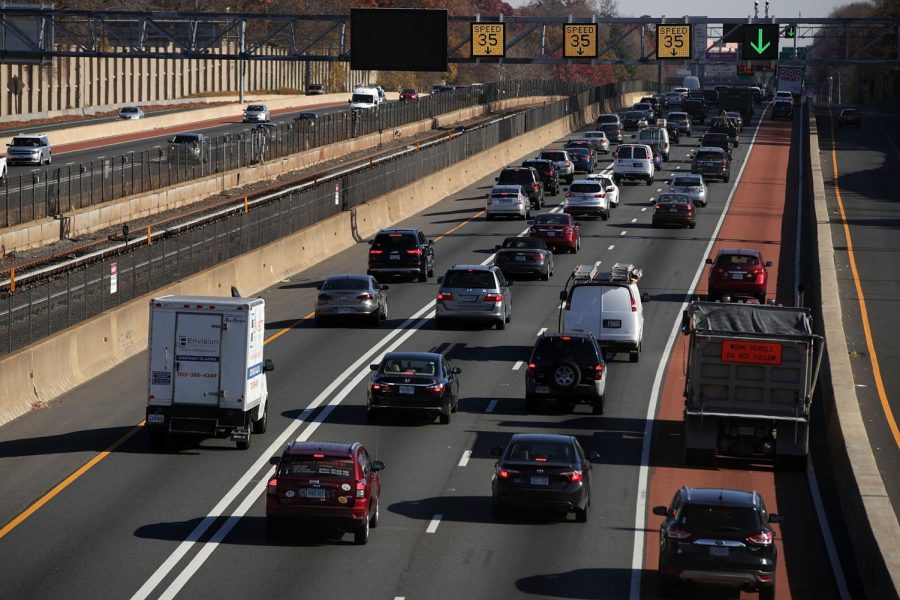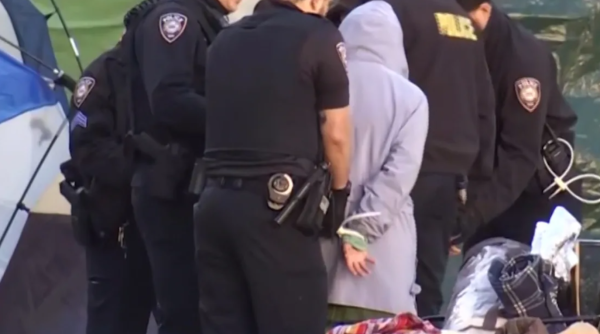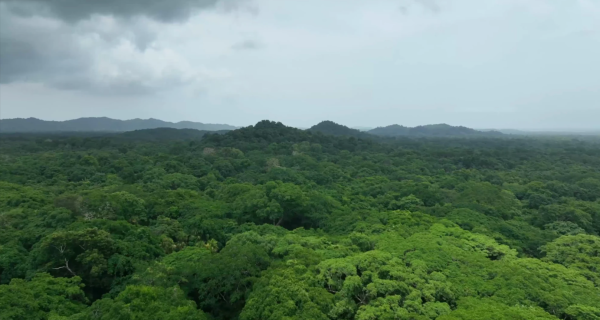10 ways to avoid Covid-19 during your holiday road trip
Slow automobile traffic on I-66 November 23, 2016 in Dunn Loring, Virginia. AAA has predicted that it will be more crowded than usual to travel this Thanksgiving with nearly 49 million Americans driving or flying to their destinations.
November 19, 2020
(CNN) — “Are we there yet?”
You don’t have to be a kid to wish the car ride home for the holidays would speed up. But if there was ever a time to stop, look and proceed with caution, it’s 2020, the year of a pandemic that’s claimed nearly 1.4 million lives globally, including more than a quarter of a million people in the United States.
Car travel comes with its own dangers — statistics show someone dies in a car crash every 24 seconds. Add on the worry of contracting a deadly virus that’s skyrocketing in many US states and countries across the globe, and it’s easy to see why experts say spending the holidays at home with our “bubble” of close friends and family is the safest route for everyone.
“My family will not be together this year for the first time in 27 years. It’ll be me and my wife in our bubble, and we’ll have a nice Zoom gathering, I suspect, to see how everybody is doing,” Dr. Francis Collins, the director of the National Institutes of Health, told CNN’s Wolf Blitzer Tuesday.
The surge of new Covid-19 infections and hospitalizations in the United States is “substantially steeper than anything we saw back in the spring with New York and New Jersey or in the summer with the Southeast,” Collins said.
“This is significantly worse. It’s moving faster. It is basically putting everybody in the country at risk,” he said. “People need to be deciding right about now, if they haven’t already, how are they going to keep themselves and their families safe at this time of great peril.”
But if you must travel, and some 48 million Americans are expected to hit the road for Thanksgiving this year, here are 10 tips to protect you and your family from Covid-19 along the way.
1. Weigh the decision to travel
Don’t travel if you are sick or if you have been around someone with Covid-19 in the past 14 days, warns the US Centers for Disease Control and Prevention, and don’t travel with someone who is sick.
To be sure you’re not sick and taking the virus along with you to your loved ones, quarantine with your family or traveling companions for two weeks — that’s the typical amount of time it takes for the virus to replicate and subside, even if you have no symptoms.
Stay on top of the rate of virus transmission at your destination — cases are spiking across the country. You can do that at the county level at the Covid-Lab at the Children’s Hospital of Philadelphia or at Johns Hopkins University’s Coronavirus Resource Center.
“The more cases at your destination, the more likely you are to get infected during travel and spread the virus to others when you return,” the CDC says.
If you or loved ones at your destination are at high risk for severe illness if you catch Covid-19, you might want to rethink your travel plans.
2. Prep the car in advance
Avoid potential car problems that might involve unintended contact with others along the way by having your car fully serviced before your trip — at minimum check oil, fluids, breaks, tires and antifreeze.
For any road trip, pandemic or not, the Federal Emergency Management Agency recommends prepping a car emergency kit that includes jumper cables, flares or reflective triangle, an ice scraper, blankets, maps and cat litter or sand in case you need something for better tire traction.
Pack several back-up phone chargers, and just in case you lose cell service in some remote area, download your main maps to your phone or GPS.
3. Don’t forget to safeguard the humans
Prep a first-aid kit for the humans in the car, too, along with plenty of water and healthy snacks, as well as extra masks for travelers older than 2.
Be picky about your mask. Don’t wear anything you can hold up and see through. In fact, studies have shown that cotton masks with two or three layers of fabric are more protective than single-ply masks or bandanas. In fact, a recent study found bandanas and gaiter masks to be least effectivein protection.
Along with that highly protective mask, you should definitely bring disinfecting wipes and hand sanitizer with greater than 60% ethanol or 70%isopropyl alcohol. According to the CDC, that’s the level needed to kill most coronaviruses.
Check the ingredients for alcohol levels instead of relying on “99.9%” effective claims, or look for the US Food and Drug Administration’s “Drug Facts” label. You can also check out the FDA list of approved disinfectants.
Tip: Don’t use any hand sanitizer that’s been stored in the car during the summer or left in the sun, the FDA says. Effectiveness will start to break down above 105°F.
4. Carefully plan your route
Many states have travel restrictions, so it’s a good idea to map out the roadways you’ll be taking and the states you’ll be passing through. CNN has a list of travel restrictions by state that is updated regularly, but you should check the links to each state’s website for potential last-minute changes before you enter the state.
5. Try not to stop
If it’s at all possible, try to complete your road trip without stopping.
“Making stops along the way for gas, food or bathroom breaks can put you and your traveling companions in close contact with other people and frequently touched surfaces,” warns the CDC.
That’s obviously not going to happen if you are traveling with little kids for more than a few hours.
Bathroom breaks can be tricky — some gas stations and fast-food restaurants have closed their restrooms — so If the opportunity to use the toilet presents itself, encourage everyone in the car to do so.
6. Sanitize everything you touch
Always wear a mask when you leave your car, suggests the American Academy of Pediatrics, and carry sanitizing wipes and hand sanitizer to wipe down door handles and knobs and toilets.
After using the restroom, wash your hands with soap and water for at least 20 seconds (the amount of time it takes to sing “Happy Birthday” twice), open the bathroom door with a hand towel, and use hand sanitizer before touching your car keys or door handles after leaving the facilities.
When refilling at a gas station, use sanitizing wipes on the gas nozzle handles and payment buttons at the pumps before you touch them, then sanitize your hands immediately after you’re finished.
7. Keep the windows cracked
Traveling in a car is obviously “a very tight, enclosed space,” said Dr. Henry Wu, an associate professor of infectious diseases at Emory University School of Medicine in Atlanta.
That’s less of an issue if you’re traveling with immediate family from your quarantine bubble. In cases where that’s unavoidable, everyone in the car should be masked.
In either scenario, crack the windows, even if it’s cold or rainy, said Joseph Allen, director of the Healthy Buildings program at the Harvard T.H. Chan School of Public Health.
He and his team studied airborne transmission inside cars and found “rolling down the windows just a couple inches” can boost air flow and dilute the virus.
Allen also warns against using the recirculation button in your car on the trip. That’s the symbol of a car with an arrow in the middle.
“if you’re going to have the air conditioning or the heater on be sure that you don’t have the recirculating option selected so you’re breathing the same air,” Allen said. “You want fresh outside air to enter the car.”
8. Have a dining plan
When it comes to reducing the risk of contracting Covid-19 while eating on the road, it’s always going to be safer eating outside, where the virus can dissipate into the open air, experts say.
The partitions and six-foot spacing installed in many indoor restaurants isn’t enough protection, said Linsey Marr, the co-author of a paper on airborne transmission of Covid-19 via very small droplets called aerosols that can float for hours.
“I think the six feet indoors is not enough by itself” and “plexiglass panels protect against large droplets, but they do not protect against aerosols,” said Marr, a professor of civil and environmental engineering at Virginia Tech.
“You have to have good ventilation in that bar or restaurant,” she added. “And since I can’t wear a mask while I’m eating, I’m just avoiding indoor restaurants until this is over.”
Getting takeout or using a drive-through and eating in your car or sitting outside is a better option, experts say.
9. Choose your hotel carefully
If you have to stay at a hotel during your trip, consider booking one with outdoor access, Marr suggests.
“This is the time to stay in one of the cheaper motels that has the outdoor corridor so you don’t have to go indoors, through the lobby, into the elevator or through the hallways,” Marr said.
“You just go up the stairs outside to your room,” she added. “And those types of rooms usually have their own air conditioning or heating systems so there’s no exchange of air between different rooms.”
If you can do it, book a room that’s been vacant for more than 24 hours as well as cleaned and disinfected. That’s an extra precaution, as is bringing your own pillows and pillowcases and even an extra sheet set.
“In terms of the air quality, I think the longer the room’s been vacant, the safer it should be,” said Emory’s Wu.
Try to avoid other guests as much as possible, Wu advises. Many hotels have closed common spaces such as pools, restaurants and public bathrooms, but you can also avoid interactions with others by checking in and out during off hours.
The CDC recommends caution when touching surfaces in any public areas, including the front desk or check-in counter, pens at the front desk, room keys, key cards, elevator buttons, water fountains, ATM or card payment stations and ice vending machines.
Carry disinfecting wipes with you as you navigate shared spaces, then use hand sanitizer or wash your hands with soap and water for a full 20 seconds.
When you get to the room wipe down door handles, light switches, remote controls and bathroom fixtures with disinfecting wipes before using them, Wu suggests.
10. Take precautions when you arrive
Ideally, you’ve quarantined before you left and taken proper safety precautions during your road trip. If not, then try to quarantine when you arrive.
“Don’t rely on a negative test on Tuesday before Thanksgiving and think that clears you,” said pediatrician Dr. David Rubin, who directs PolicyLab, a research and public policy center at Children’s Hospital of Philadelphia that’s tracking Covid-19 cases in communities across the country.
“Hunkering your family down for a week and a half is your best way to assure that you’re likely to be negative,” Rubin added.
If that wasn’t possible, then try to have holiday gatherings outside in the open air to reduce risk. That’s especially critical for loved ones at high risk for the virus — that includes people who are pregnant, or obese, or 65 or older, or suffer from immune issues or kidney, heart, sickle cell or pulmonary disease or diabetes.
“The decisions we make now around the Thanksgiving holiday really determine just how bad the depths of winter are when it comes to the spread of the virus,” Allen said.
“If we’re irresponsible for a short-term gain through the holidays, it really can come back and bite us weeks later with an expansion of cases,” Allen said. “And cases lead to hospitalizations and hospitalizations lead to death.”
The-CNN-Wire™ & © 2020 Cable News Network, Inc., a WarnerMedia Company. All rights reserved.

















